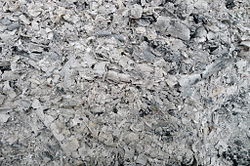This article is missing information about non-ornithological uses of this term.(June 2023) |
| Cinereous | |
|---|---|
 Wood ash from a campfire | |
| | |
| Hex triplet | #b7b7b7 |
| sRGB B (r, g, b) | (183, 183, 183) |
| HSV (h, s, v) | (0°, 0%, 72%) |
| CIELChuv (L, C, h) | (74, 0, 0°) |
| Source | Maerz and Paul [1] |
| ISCC–NBS descriptor | Light grayish brown |
| B: Normalized to [0–255] (byte) | |
Cinereous is a colour, meaning ashy grey in appearance, either consisting of or resembling ashes, or a grey colour tinged with coppery brown. It is derived from the Latin cinereus, from cinis (wood ashes).
Contents
The first recorded use of cinereous as a colour name in English was in 1661. [2]



